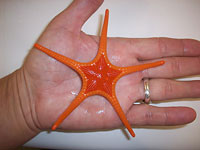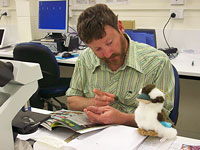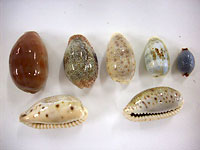

 | |||||||||||
|
|
Journals 2008/2009Zamaria Rocio
September 1, 2008 After working up another coral head this morning, I decided to use the microscopes and my digital camera to take pictures. First I put a hermit crab under the dissecting microscope, and was amazed the quality of picture. Hermit crabs (Dardanus lagopodes) live in abandon snail shells. Their long tails fit nicely in the shells, while their large claws can block the opening. Because they grow and molt, they are will constantly look for a larger shell to fit them. This is one reason why you should not remove shells from the area. They eat small reef animals like polychaetes. 
The scientist studying Echinoderms always had a collection of interesting animals at his work area in the laboratory. I should not find this usual since he has had his own personal collection of sea urchins exhibited in the Australian Museum. His name is Ashley Miskelly and he is truly an expert in his field. He has written a book entitled Sea Urchins of Australia and The Indo-Pacific in 2002, which I was able to look at while I was here. He was in the process of writing another book but this one was on strange and beautiful Echinoderms he has found.
While here he found some cowry shells to bring back to his collection. I am told that collectors would pay a lot of money for rare species. Cowries have many different patterns on their glossy shells. The shell has that distinctive pinch at each end and the opening is just a slot. Cowries can be found on rocks and coral reefs.
Ashley found a very unique sea star. I was no bigger that the palm of my hand. It was brilliant orange with a darker star shape on its central body disc. This is an Echinodrm with radial symmetry and tube feet along each arm. Sea stars need to be near each other to spawn so that their eggs would get fertilized. Its larval stage develops in the plankton, and then eventually settles on the ocean's floor to become the sea star we know. Most sea stars will have five arms, which can regenerate if cut off. This is one way they can reproduce. 
|
||||||||||

